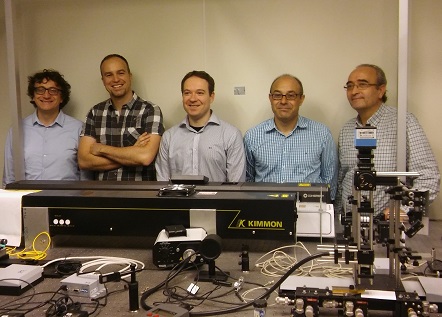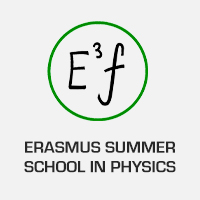
Research teams of three Valencian universities, among them the Universitat de València, and the Italian National Council of Research have developed a new experimental device which generates quantum light emission compatible with optical fibre communications. The work, published today in the journal ‘Scientific Reports’, is presented as a technological alternative to the development of quantum technologies of the information.
This work is the result of a collaboration project between research teams in communications engineering and nanotechnology, formed by Juan P. Martínez Pastor (Universitat de València), Salvador Sales Maicas and Guillermo Muñoz Matutano (Universidad Politécnica de Valencia), Carlos Rodríguez Fernández-Pousa (Universidad Miguel Hernández de Elche) and Luca Seravalli (Universidad de Parma–Italian National Research Council).
The team have designed and made devices integrated in fibre which allow filtering the light emitted by quantum dot (QDs), with an efficiency 10 times bigger than the usual one. This increase in efficiency of filtering has allow working with closed infrared detectors simpler and cheaper.
On the other hand, the selection of photons through optical fibre opens the door to future devices compacter and more versatile, where the transmitting agent of light (optical fibre) can be the main element on the manipulation of information between photons.
Juan Martínez Pastor, full university professor of Applied Physics and Electromagnetism of the Universitat de València, has highlighted that the laboratory of the Universitat has been pioneer in Spain in quantum light analysis emitted by Qds and the unique that can do this kind of experiments in infrared windows in telecommunications, here just a few laboratories of the international scientific community work nowadays. ‘ion a close future we are planning to do experiments with entangled photons, base of the quantum cryptography and other important applications, like quantum teleportation and sensors in atomic and molecular level’, has explained.
‘The consecution of this technological alternative has shown a transversal challenge to work areas, like the semiconductors physics, the nanotechnology, the photonics and quantum optical’, points Guillermo Muñoz, doctor un the Universitat de València, researcher Juan de la Cierva in the Group of Optical and Quantum Communications of the Universitat Politècnica de València and collaborator of the Institute of Material Sciences of the UV.
Quantum dots are informally labelled like ‘artificial atoms’. The small size of these nanostructures (10-9 nanometres), affects directly its electronic and optical properties, and makes them similar to the one of atoms.
QDs incorporate all the advantages of semiconductor technology, which can be incorporated as a base for lots of optoelectronic devices, like LEDs and low power lasers. However, when QDs are studied in a isolated way, and analysing the optical emission of one of them, the most of the applications are focused in the development of quantum communications. The device of light filtering with the optical fibre has been designed and made in the UPV by the doctor David Barrera, researcher of the group Salvador Sales of the ITEAM.
The work, published today Friday by the journal of the prestigious editorial Nature Publishing Group (NPG), highlights that one of the requirements to the development of these quantum technologies is to get close basic research to technological and industrial requirements. As the authors explain in their article, to make this technology based on quantum light with QDs compatible with the current technological claims, is vitally important to make its optical emission embraces interesting areas in telecommunications with optical fibre. (1300 and 1500 nanometres).
Two different technologies
Carlos Rodríguez Fernández-Pousa, professor of the Universidad Miguel Hernández of Elche, driver of the experiment, has highlighted: ‘the advance is consequence of the interrelation of two difgerent technologies, the one of optical devices based on quantum dots of semiconductor, and the ones of optical fibre to the filtering of signals. This is precisely the success in the connection of these different technologies which allow discerning additional developments in this field’.
‘The current research presents lots of challenges to solve before frame it as a commercial technology, like make it works in room temperature, but it is shown as a very significant advantage to develop cheaper, more efficient and compacter technologies in the field of the control and management of photons for telecommunications and quantum information’, has completed Guillermo Muñoz.
‘These advantages and our experimental capacities allow us positioning in a good place in the field of the recently announced Flagship of Quantum Technologies (https://ec.europa.eu/digital-single-market/en/news/european-commission-will-launch-eu1-billion-quantum-technologies-flagship), project with a budget of 1.000 millions of euros and where Quantum Communications are the priority axis, and that the Ministry of Economy and Competitiveness pretends to support’, has pointed Francisco Martínez Pastor.
Devices
This work is part of the main lines of research of Guillermo Muñoz and his project Juan de la Cierva financed by the Ministry of Economy and Competitiveness. In the same laboratory of the Institute of Material Sciences of the Universitat de València (ICMUV) had already developed different devices for the treatment and control of photons emissions, like the proposal of new ideas for the development of the logical processing of the information using quantum light, finalist of the prize IDEA for young researchers and published two years ago in the prestigious journal Nano Letters (Nano Lett., 2014, 14, pp 456–463), or the proposal of a new technique of correlation measure of photons (patent presented by the Universitat de València and the Universitat Politècnica de València).
Article:
Muñoz-Matutano, G. et al. All-optical fiber Hanbury Brown & Twiss interferometer to study 1300 nm single photon emission of a metamorphic InAs Quantum Dot. Sci. Rep. 6, 27214; doi: 10.1038/srep27214 (2016)
Images:


























